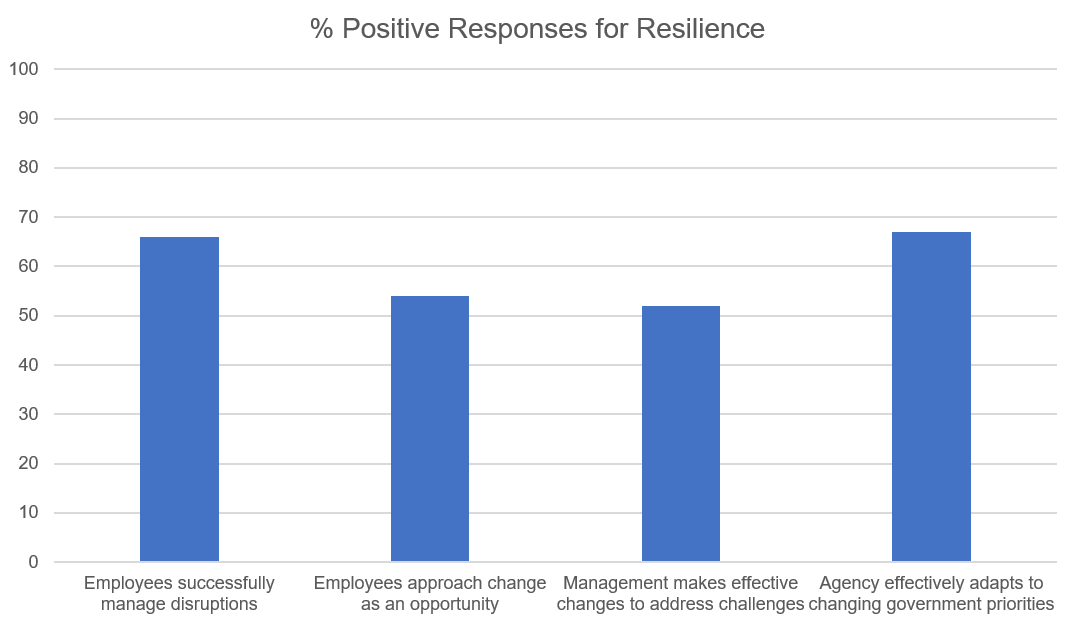
What the new measures in 2022 FEVS reveal about the federal workforce
The 2022 Federal Employee Viewpoint Survey added new questions about innovation and resilience, as well as a new index on diversity, equity, inclusion and...
After shortening the Federal Employee Viewpoint Survey for two years during the COVID-19 pandemic, the Office of Personnel Management fully restored, and then added some, to this year’s iteration of the survey.
The topline numbers for the 2022 FEVS results showed that employee engagement stabilized this year, although several other indices, like job and pay satisfaction, declined. Beyond employee engagement scores remaining the same between the 2021 and 2022 FEVS results, though, new questions on innovation and resilience this year revealed how employees feel about their agency’s ability to think of new approaches to work, and handle changing government priorities.
“Other new content added to the 2022 survey includes assessment around changing conditions impacting employees and agencies,” OPM said in an Oct. 20 press statement. “Three new measures are particularly relevant to the future of work and government priorities; they include resilience, innovation and customer responsiveness.”
For innovation, a section that OPM is newly evaluating, several new survey questions asked respondents about how much agency leaders encourage and support new ideas and approaches in their work. Although roughly two-thirds of FEVS respondents agreed that employees incorporate new ideas into their work, a smaller percentage of respondents had positive perceptions of their agency managers’ role, with 56% agreeing that management encourages innovation.
According to the results, 64% of respondents agreed that employees consistently look for new ways to improve work. In the lowest-scoring question about innovation for FEVS, just over half of respondents agreed that their agency puts resources – like budget, staff and time – toward developing new ideas.

Along with innovation, resilience was another major theme of the 2022 FEVS, looking at how agencies and employees navigate through tumultuous changes in their work environment.
OPM added several new questions to the survey, asking respondents about their perception of managers’ and coworkers’ ability to be resilient during changes, such as returning to a physical workplace after fully teleworking.
About two-thirds of 2022 FEVS respondents agreed both that their work unit successfully manages disruptions to our work, and that their organization effectively adapts to changing government priorities.

The other two new survey questions on resilience — asking about the role of managers and the ability of an agency to approach change as an opportunity — both received lower results, with positive perceptions for just over half of the responses.
In addition to new questions about innovation and resilience, an entirely new index on diversity, equity, inclusion and accessibility showed that 69% of FEVS respondents had positive perceptions of their agency’s DEIA practices. But breaking down the data further showed some areas of DEIA fared better than others.
OPM launched the new DEIA index in FEVS to measure federal employees’ perceptions on agencies’ progress toward long-term DEIA goals for the government. The index is specifically designed to align with the Biden administration’s executive order on advancing DEIA in the federal workforce, according to OPM. The order required agencies to integrate DEIA priorities into their recruitment, hiring, training, leadership development, employee pay and benefits, and much more. Along with the DEIA strategic plans that all agencies are required to develop, they’re also tasked with laying out concrete strategies to advance equity in federal services.
Beyond the overall 2022 FEVS results showing that 69% of respondents reported positive perceptions of their agency’s DEIA-related practices, OPM broke down the survey further to ask about each of the four individual categories. Inclusion was the highest-performing section, at 75% positive responses, while equity had the lowest positive perception, at 65%.

The index is brand new, but over time it’ll help OPM measure any long-term changes in employees’ perception of DEIA practices. The index comes along with many other DEIA-related priorities for agencies, covering the administration’s goals like diversifying internal workforces and making more federal internships paid positions.
“These governmentwide results will serve as a baseline to assess future changes as well as benchmark comparisons for agency DEIA initiatives,” OPM said.
Beyond publishing the initial data for 2022 FEVS, OPM will release its traditional management report in November, which will provide further analysis on the survey results.
And as usual, the results of the 2022 FEVS will inform the Partnership for Public Service’s annual Best Places to Work in the Federal Government rankings. The Partnership plans to release those results in early 2023, on par with years prior to the COVID-19 pandemic.
Copyright © 2025 Federal News Network. All rights reserved. This website is not intended for users located within the European Economic Area.
Drew Friedman is a workforce, pay and benefits reporter for Federal News Network.
Follow @dfriedmanWFED





